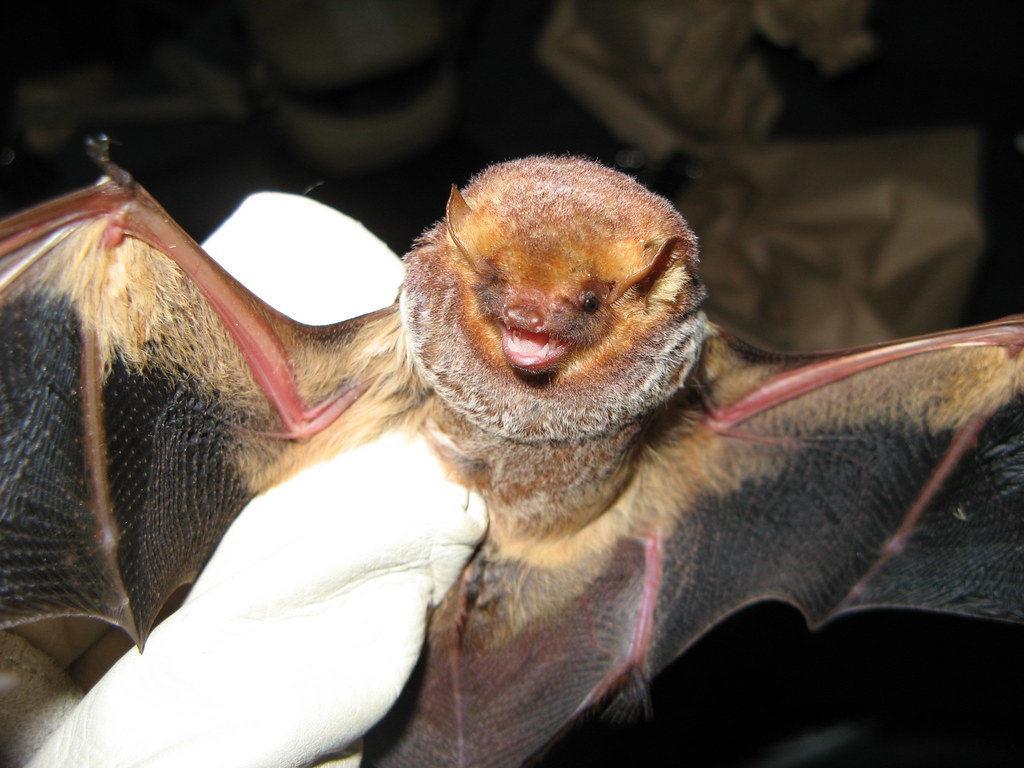Seminole Bat (Lasiurus seminolus)

Key Takeaways
- The Seminole Bat is a small mammal with bright reddish-orange fur, long pointed wings, and large rounded ears.
- It can be found in forests, wetlands, and open areas in Florida, Georgia, Alabama, and Mississippi.
- The Seminole Bat primarily feeds on flying insects and prefers larger-bodied insects for a more energy-rich food source.
- Conservation efforts should focus on protecting habitats and suitable roosting sites to ensure the long-term survival of the Seminole Bat.
Physical Characteristics
What are the physical characteristics of the Seminole Bat (Lasiurus Seminolus)? The Seminole Bat, also known as the Florida red bat, is a small mammal belonging to the Vespertilionidae family. It is characterized by its bright reddish-orange fur, which provides excellent camouflage against the foliage of its natural habitat. The average length of an adult Seminole Bat is around 4.5 to 5 inches, with a wingspan of about 11 to 13 inches. The males are slightly larger than the females.
One of the most notable physical features of the Seminole Bat is its long, pointed wings, which enable it to maneuver swiftly through the dense vegetation. This adaptation allows the bat to catch insects while in flight, its primary food source. Additionally, the Seminole Bat has large, rounded ears and a well-developed echolocation system, which aids in navigation and hunting.
In terms of population trends, the Seminole Bat is considered a species of least concern by the International Union for Conservation of Nature (IUCN). However, like many other bat species, the Seminole Bat faces threats such as habitat loss and degradation due to urbanization and deforestation. Increased awareness and conservation efforts are needed to ensure the long-term survival of this important species and its behavioral adaptations.
Habitat and Distribution
The Seminole Bat (Lasiurus Seminolus) is typically found in a variety of habitats throughout its distribution range. These bats are known to inhabit forests, wetlands, and open areas, making them adaptable to diverse environments. They can be found in the southeastern United States, specifically in Florida, Georgia, Alabama, and Mississippi.
Habitat selection by Seminole Bats is influenced by factors such as roost availability, prey abundance, and suitable environmental conditions. They are known to roost in a variety of structures, including tree hollows, buildings, and bat houses. These bats are also known to migrate seasonally, with some individuals traveling long distances to reach preferred habitats.
Understanding the population dynamics of Seminole Bats is essential for their conservation. Research suggests that these bats may experience fluctuations in population size due to various factors, including changes in habitat availability, climate, and disease outbreaks. Additionally, their migration patterns may also impact population dynamics, as individuals may face challenges during long-distance travel.
Conservation efforts for Seminole Bats should focus on protecting their preferred habitats, ensuring the availability of suitable roosting sites, and minimizing disturbance during their migration periods. Monitoring population trends and understanding the factors influencing their population dynamics will help inform conservation strategies to ensure the long-term survival of this species.
Feeding Behavior
Seminole Bats exhibit a diverse feeding behavior, influenced by their habitat selection and prey availability. These bats are insectivorous and primarily feed on a variety of flying insects, such as moths, beetles, and flies. They are known to use a range of foraging techniques to capture their prey, including aerial hawking and gleaning. Aerial hawking involves capturing insects in flight, while gleaning refers to picking insects off vegetation or the ground.
The prey preferences of Seminole Bats may vary depending on the availability and abundance of different insect species in their habitat. Research has shown that they tend to select larger-bodied insects, which provide a more energy-rich food source. This preference for larger prey may be influenced by the bat’s energy requirements and the efficiency of capturing and consuming these prey items.
To help visualize the feeding behavior of Seminole Bats, the following table provides an overview of their foraging techniques and prey preferences:
| Foraging Techniques | Prey Preferences |
|---|---|
| Aerial hawking | Larger-bodied insects |
| Gleaning | Flying insects |
Understanding the feeding behavior and prey preferences of Seminole Bats is essential for conservation efforts. By protecting their habitats and ensuring the availability of suitable prey, we can help maintain healthy populations of these bats, contributing to the overall balance of ecosystems they inhabit.
Reproduction and Life Cycle
The reproductive process and life cycle of the Seminole Bat (Lasiurus Seminolus) are characterized by a complex series of mating rituals and the development of offspring from birth to adulthood. These bats have a well-defined mating season, which typically occurs in the late summer or early fall. During this time, males exhibit courtship behavior to attract females. This behavior may include vocalizations, wing displays, and scent marking.
Once a male successfully attracts a female, mating occurs. Female Seminole Bats can store sperm internally and delay fertilization until conditions are optimal for the survival of their offspring. After a gestation period of approximately three months, the female gives birth to a single pup, which is typically born in late spring or early summer.
The newborn pups are completely dependent on their mothers for nourishment and care. They are born hairless and blind, relying on their sense of touch and hearing to locate their mother’s nipple and feed on her milk. As they grow, the young bats develop their flight and hunting skills under the guidance of their mother.
It takes several weeks for the pups to gain enough strength and coordination to fly on their own. Once they reach this stage, they are considered juveniles. Juvenile Seminole Bats continue to develop and refine their hunting skills, gradually becoming independent from their mothers. It takes about a year for them to reach full adulthood and become reproductively mature. During this time, they may form small social groups with other bats of their species.
Understanding the reproductive behavior and life cycle of the Seminole Bat is crucial for its conservation. By studying their courtship behavior and mating patterns, researchers can better understand their population dynamics and implement effective conservation strategies. Protecting their habitats and ensuring the availability of suitable roosting sites are essential for the survival of this species.
Conservation Status
Given its vulnerable status, it is important to assess the conservation status of the Seminole Bat (Lasiurus Seminolus) in order to develop effective measures for its protection. Understanding the threats faced by this species and implementing appropriate conservation efforts is crucial for its survival.
Threats and conservation efforts
- Habitat loss: The conversion of forests into agricultural land and urbanization are major threats to the Seminole Bat. Conservation efforts should focus on preserving and restoring its natural habitat.
- Pesticide use: The use of pesticides in agriculture can have detrimental effects on bat populations. Implementing sustainable farming practices and promoting the use of bat-friendly pesticides can mitigate this threat.
- White-nose syndrome: This fungal disease has decimated bat populations in North America. Monitoring and research efforts should be intensified to understand the spread of the disease and develop strategies to combat it.
- Wind energy development: As wind farms expand, they pose a significant threat to bats due to collisions with wind turbines. Implementing mitigation measures such as adjusting turbine operation during peak bat activity can reduce this impact.
Population trends and monitoring methods
- Population declines: The Seminole Bat population has experienced significant declines in recent years. Regular monitoring using acoustic surveys and roost counts is essential to track population trends and identify areas of concern.
- Citizen science: Involving the public in data collection and monitoring efforts through citizen science initiatives can provide valuable information on the distribution and abundance of the Seminole Bat.
- Genetic monitoring: Genetic analysis can help assess the genetic diversity and structure of bat populations, providing insights into their overall health and vulnerability to environmental changes.
- Long-term monitoring: Long-term studies are necessary to track changes in population size and distribution over time, allowing for adaptive management strategies to be implemented.
Bat Species
Rafinesque’s big-eared bat (Corynorhinus rafinesquii)
Silver-haired bat (Lasionycteris noctivagans)
Little brown bat (Myotis lucifugus)
Indiana bat (Myotis sodalis)
Virginia big-eared bat (Corynorhinus townsendii virginianus)
Red bat (Lasiurus borealis)
Gray bat (Myotis grisescens)
Eastern small-footed myotis (Myotis leibii)
Evening bat (Nycticeius humeralis)
Big brown bat (Eptesicus fuscus)
Hoary bat (Lasiurus cinereus)
Southeastern myotis (Myotis austroriparius)
Northern bat (Myotis septentrionalis)
Eastern pipistrelle (Pipistrellus subflavus)
Bat Related Diseases
Histoplasmosis
Rabies
White-Nose Syndrome
Nuisance Bat Topics
Frequently Asked Questions
Common questions about Seminole Bats (Lasiurus seminolus) often revolve around their physical characteristics, habitat, behavior, diet, and conservation status.
What do Seminole Bats look like?
Seminole Bats are medium-sized bats with a rich mahogany fur that is frosted at the tips, giving them a distinct reddish-maroon hue. They have a wingspan of 11 to 13 inches and weigh between 0.3 to 0.5 ounces. Both males and females have similar coloring, which is not sexually dimorphic. They are often confused with the red bat due to their coloring[1][6][7][11].
Where do Seminole Bats live?
Seminole Bats are common in the southeastern United States, with their range extending from East Texas to the Southern Atlantic coast and to the northern parts of Arkansas and North Carolina. They are found in lowland forest stands of mixed deciduous and pine trees. They typically roost alone, hanging 1.5 to 6.1 m above the ground on the southwest side of trees, clinging to the inside of clumps of Spanish moss, leaves, or loose bark[2][9].
What is the behavior of Seminole Bats?
Seminole Bats are a solitary species. Unlike other bat species, Seminoles do not hibernate or go into deep torpor. Weather permitting, these bats will be active during winter months. While these bats are known to make southern migrations, not much is known about how they do so[3].
What do Seminole Bats eat?
Seminole Bats are insectivores, known to feed on ants, bees, wasps, beetles, moths, crickets, dragonflies, and flies. They typically feed in places where insects gather, such as forest edges, over open ponds, and near lights[1][3][4].
What is the conservation status of Seminole Bats?
Seminole Bats are listed as “least concern.” While there is currently no research to determine whether Seminole bats are affected by humans collecting Spanish moss or not, there’s a chance these collections could affect roosting behavior. White-Nose Syndrome is currently not an issue for Seminoles but their populations are being watched for signs of the disease[3].
What is known about Seminole Bats’ reproduction?
Not much information is known about Seminole bats’ mating behaviors, but mating is known to occur during the fall. Females store sperm during the winter with fertilization happening in spring. Females usually have between 1 and 4 offspring and carry out parental care[3].
Are Seminole Bats common in my area?
This would depend on the specific location. For example, in Tennessee, these bats are considered uncommon and are not listed for protection[9]. In Kentucky, there are less than two dozen records of this southern bat, suggesting the bat’s range is potentially expanding[4].
How do Seminole Bats differ from other bat species?
Seminole Bats are often confused with the red bat due to their similar coloring. However, the deep mahogany color of their fur is distinctive from the reddish-orange color of eastern red bats. Unlike other bat species, Seminoles do not hibernate or go into deep torpor[1][3][6].
Citations: [1] https://myfwc.com/conservation/you-conserve/wildlife/bats/field-guide/seminole-bat/ [2] https://animaldiversity.org/accounts/Lasiurus_seminolus/ [3] https://www.ncbwg.org/seminole-bat-lasiurus-seminolus/ [4] https://fw.ky.gov/Wildlife/Pages/Seminole-Bat.aspx [5] https://tpwd.texas.gov/huntwild/wild/species/seminole/ [6] https://en.wikipedia.org/wiki/Seminole_bat [7] https://agrilife.org/batsinschools/about-bats/solitary-bats-in-texas/seminole-bat/ [8] https://www.batcon.org/bat/lasiurus-seminolus/ [9] https://www.tn.gov/twra/wildlife/mammals/mammals-bats/seminole-bat.html [10] https://dwr.virginia.gov/wildlife/information/seminole-bat/ [11] https://www.nps.gov/ever/learn/nature/seminolebat.htm [12] https://animalia.bio/seminole-bat [13] https://www.floridabats.org/seminole-bat.html [14] https://thecritterteam.com/species/bats/seminole-bats/ [15] https://www.captainmitchs.com/seminole-bat/ [16] https://crittercontroloftampa.com/blog/questions-about-bats-youve-always-wondered/

